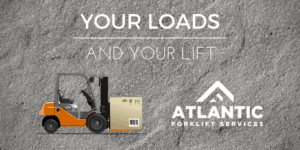 From your standard pallet-mounted load to rolls of carpet or bales of cotton there are as many types of loads as you can imagine.
From your standard pallet-mounted load to rolls of carpet or bales of cotton there are as many types of loads as you can imagine.
So, what do you need to consider for your forklift depending on the load you are moving most often?
Since we love lists so much- here is a list of the Four Things You Should Consider in Your Loads, and Your Lift.
- Size: It starts here. Length, width, height and weight of your load need to be considered first. Loads that can be managed from a standard-sized palette (48-inches) are obviously the easiest to manage. Depending on the shape, you can even stack palettes or move multiple palettes side by side. Other loads may need specific accessories or attachments to make moving them more efficient. Specifically, we’re thinking of carpet rolls here, where a large prong on the front end of your lift enables you to move a long roll of carpeting easily.
- Storage: Where is your load going? On shelves, into a truck, into a warehouse? This can determine how tall your lift needs to be, and what type of wheel base your lift needs. Does it need to maneuver in narrow passageways?
- Surface: Where is your forklift going to be used? Inside or outside? Paved surface or rough terrain? This will determine your tire selection, even down to non-marking tires that won’t scuff up your warehouse floor.
- Frequency: How many times a day are you actually moving the product and how long will your forklift be in operation over the course of an 8-hour shift? This helps you determine what power supply you could choose for your forklift- batteries? LP Gas?
As always, our experts have decades of experience working with forklifts inside and out. If you have a question, there’s no one more qualified to answer it. Contact us and let us help you through any decisions you have to make.
